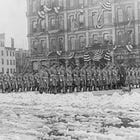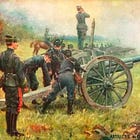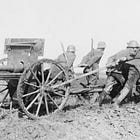The Cannon Company of the US Army Infantry Regiment (April 1942)
Battalion: An Organizational Study of United States Infantry
The estate of the late John Sayen has graciously given permission to the Tactical Notebook to serialize his study of the organizational evolution of American infantry battalions. The author’s preface, as well as previously posted parts of this book, may be found via the following links:
In the seven or so decades leading up to the Second World War, many of the serious students of military matters in the US Army found much to admire in the ideas, methods, and equipment of the French Army. Others looked to Germany for models to emulate (or, at the very least, contemplate.)
In June of 1940, the fall of France deprived obvious artifacts of the French way of war of much of their appeal. At the same time, those who championed weapons, structures, and approaches modeled on those of the victorious German Army enjoyed, if only for a season, increased influence.
The design of the antitank company the US Army infantry regiment of October 1940 owed much to this phenomenon, as did the retention of the basic features of that organization in the establishments approved in April of 1942. Similarly, the concept, design, and armament of the cannon company introduced by the tables of organization of April 1942 borrowed a great deal from the infantry gun companies of contemporary German infantry regiments. Each, for example, consisted of three platoons: two three-piece platoons armed with 75mm weapons and one two-piece platoon equipped with heavier ordnance.

The American cannon company differed from its German predecessor in two important ways. First, where the German heavy infantry gun had a caliber of 150mm, its American counterpart, with a bore of 105mm, was a much lighter piece. Moreover, where German infantry guns of 1942 were either horse drawn or pulled by prime movers, the cannon of an American cannon company were mounted on armored vehicles.
The self-propelled artillery pieces of the cannon company were created by mounting ordnance on the beds of M3 armored half-tracks. Rather than pointing backwards in the manner of portee anti-tank guns, these guns and howitzers faced forward, with their barrels hanging over the driver’s cab.
The most common of these conversions, the M3 Gun Motor Carriage, used an updated version (Model 1897 A4) of the 75mm field gun (Model 1897) that had served with horse-drawn field artillery batteries since the First World War. Three of these weapons served with in each of the two 75mm howitzer platoons of each cannon company. (The M3 also served with units of the new Tank Destroyer branch.)
The T30 Howitzer Motor Carriage, which was sometimes issued to 75mm howitzer platoons instead of the M3, made use of a 75mm pack howitzer. While firing the same projectiles as the 75mm field gun, the pack howitzer was a much lighter weapon with a much shorter barrel and the ability to fire at much higher angles.
The T30 was supposed to have been the standard 75mm weapon of the cannon company. However, the Ordnance authorities found it easier to produce the M3, which made use of an existing artillery piece, than to wait for new pack howitzers to emerge from the factories.
The T19, which served in the 105mm howitzer platoons of each cannon company, made use of the M2 105mm howitzer. Neither a true gun nor a true howitzer, the M2 also served as the standard light field piece of the Field Artillery branch.
Sources:
US Army Adjutant General Table of Organization T/O 7-14 “Infantry Cannon Company” (Washington DC 1 April 1942)
Robert R. Palmer “The Reorganization of Ground Troops for Combat” in Kent Roberts Greenfield and others The U.S. Army in World War II - The Organization of Ground Combat Troops (Washington DC: Office of the Chief of Military History 1947) page 302
For Further Reading:
For more on the interplay of Francophile and Germanophile tendencies in the US Army of the years leading up to the Second World War, see Bruce I. Gudmundsson “The Operational Cultures of US Ground Forces” in Mikael Weissman and Niklas Nilsson, Advanced Land Warfare (Oxford: Oxford University Press, 2023)
For the German experience of infantry guns in the First World War, see The Second "Assault Cannon" of Assault Battalion Rohr.
For more on the self propelled 37mm gun, see Major General E. N. Harmon “Operations of the 1st Armored Division in Tunisia” AFV-G2 (March-April 1980) pages 35-36
For a discussion of the absence of infantry guns in the British Army of World War II, see Ian V. Hogg British and American Artillery of World War II (New York: Hippocrene Books 1978)
To Share, Subscribe, or Support:










My late father served in the Cannon Company of the 320th Infantry Regiment, 35th Infantry Division which was formed in the Fall of 1943 and landed in Normandy in July 1944 as part of the reinforcements for the Normandy Campaign. Maybe this came later but they were equipped with six M3 105mm howitzers, not the M2. The M3 was originally developed for the glider airborne artillery regiments as a supplement to the 75mm howitzers and combined a shortened barrel mounted on the 75mm carriage. It required a faster burning powder than the M2 due to the shorter barrel. According to Dad, they received VT (proximity fuses) about the time of the Battle of the Bulge which simplified things since they were usually firing air bursts for anti-personnel purposes.